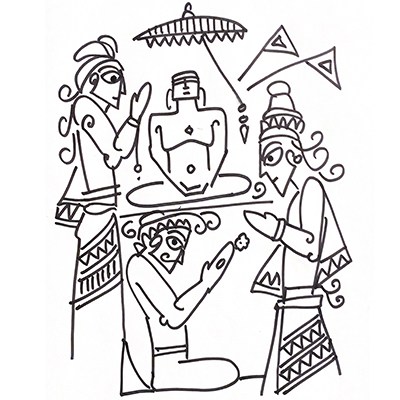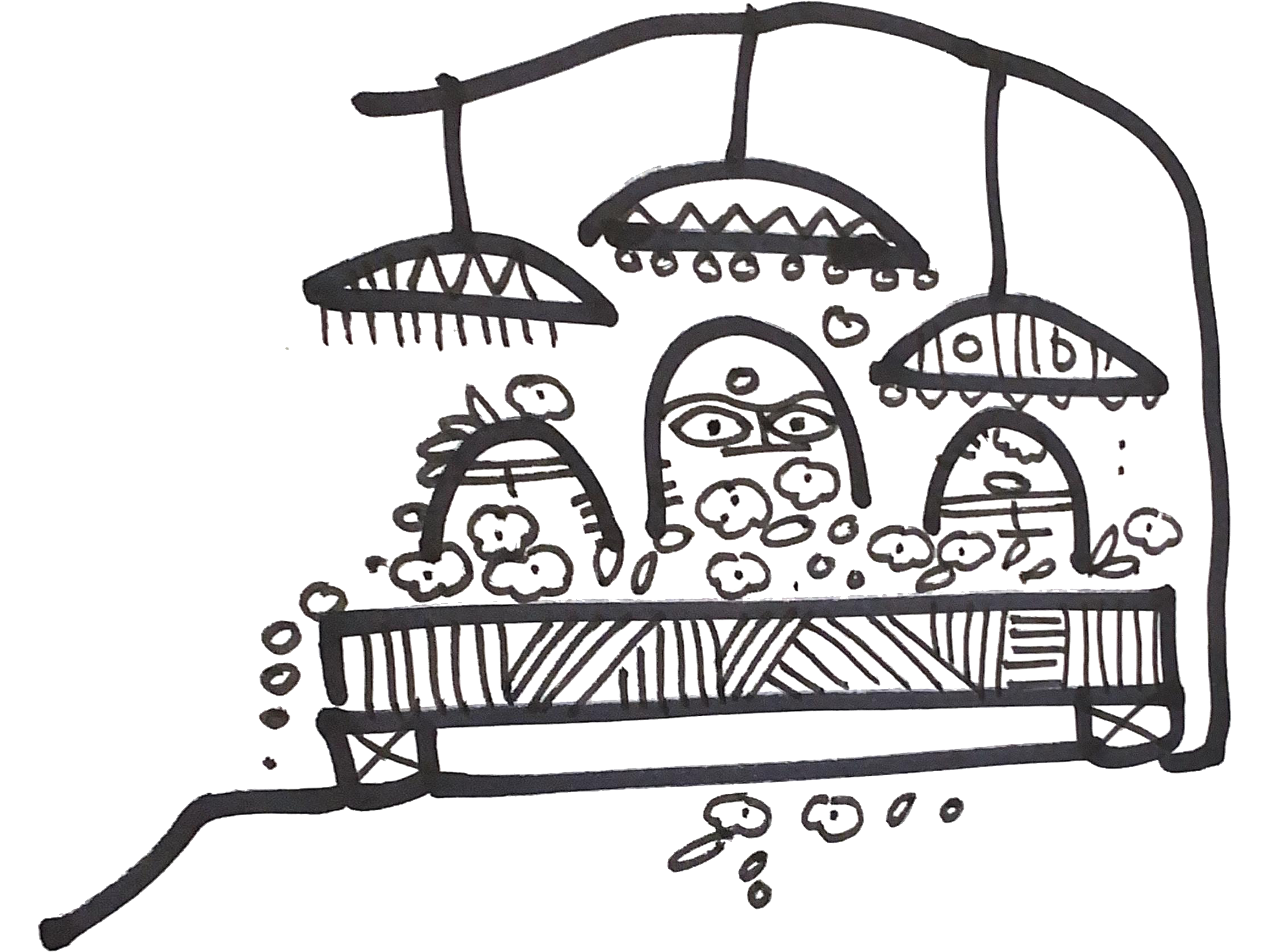Published on 3rd December, 2023, in The Times of India.
Until its revival in the 20th century by Babasaheb Ambedkar — as part of the Navayana movement for Dalit upliftment — Buddhism had all but been forgotten in the land of its birth. By contrast, Jainism maintained a tenacious hold in mainland India. This despite attempts in some Puranas to show that Tirthankara was a form of Vishnu, just like the Buddha, thereby seeking to assimilate Jainism within the Hindu fold. So, how did Jainism resist this appropriation?
Mythologically, Jainism is an eternal religion based on rebirth, a sanatan dharma, just like Buddhism and Hinduism. Historically, however, Jainism arose about 2,500 years ago in the Magadhan region, home to many monastic ideas, including Upanishads and Buddhism.
While earlier, many believed monasticism was a response to Vedic ritualism, more and more scholars are now convinced these monastic movements were an alternative worldview that emerged in the lower Gangetic basin independent of the Vedic corpus that thrived in the upper Gangetic basin.
Jainism spread northwards along the Gangetic plains to Kashi and Mathura and westwards along the Narmada towards the coasts of Gujarat and Maharashtra. It also spread southwards, which is why Jain art is found in the river basins of Odisha, Andhra Pradesh and Tamil Nadu. Like Buddhism, this spread was along trading routes and along seaports.
While kings sponsored Vedism and its multiple fire rituals, merchants and traders preferred the monastic orders of Buddhism and Jainism. Supporting monks was supposed to earn merit. Merit ensured fortune. To prevent fortune from corrupting the mind, the grace of perfected beings, such as the Jina, was required, who taught the importance of not getting attached to wealth (aparigraha).
While monks sought to outgrow hunger, the merchants struggled with charity, using profits to build monasteries and temples where monks could rest. This accounts for the fabulous early stone monuments of both Buddhism and Jainism, especially in the Deccan region.
Temples and monasteries also became centres of intellectual activity — architecture and engineering and sculpting, as well as banking and mathematics. Merchants of India were the first to use cowries and metal bits as currency. From karshapana, the ancient Indian word for coin, came the word cash. The earliest use of the decimal system and use of 0 as placeholder may have its roots in the Jain community of bankers and traders.
In North India, while Buddhism and Brahmanism competed for royal favour, Jainism shunned kings, preferring private patrons in trading communities. They avoided building monasteries like the Buddhists and preferred wandering, staying in caves only during the rainy season.
Renouncing the world
Between the third and sixth centuries, Jainism thrived in Tamil Nadu. In Tamil epics such as Silappadikaram and Jivakachintamani , we hear of Jain nuns, and heroes, who renounce the world after a lifetime of adventures. Some of the earliest Tamil works were probably written by followers of the Jain way.
As per some nationalistic scholars, this was the result of the (questionable and quite provable) ‘Kalabhra’ invasion, probably from Karnataka, probably by patrons of Jainism, who eclipsed indigenous Tamil culture until it was later resurrected by Pallava, Chola and Pandya kings who were inspired by Nayanars and Alvars, who worshipped Shiva and Vishnu.
The rise of Chola, Pallava and Pandya kings who favoured Shaivism gradually saw the decline of Jainism in the south. Unlike Jains in the north, Jains of the south did court royal favour, and the resulting rivalry may be the reason for the violence many Jains faced from newly emerging theistic orders that venerated Shiva in Tamil Nadu and Karnataka.
For centuries in India, there was no concept of religion. Everyone worshipped gods, sages and spirits who took away suffering. Brahmins invoked celestial beings for kings through yagna. Some worshipped gods such as Shiva, Vishnu and numerous village gods and goddesses.
These were the upasakas, or worshippers. Then there were those who took care of monks. These were the shravaka, householders who took care of the shramana, the hermit. Mauryan kings, Satavahana kings and Chalukya kings all patronised Brahmins and hermits of all denominations.
But things began to change about 1,500 years ago. Slowly with landed property becoming key to the economy, the caste system became firmly entrenched in India, based on who controlled the land and who worked on the land and who had a share of the harvest.
Since kings controlled the land, there was much competition to gain royal favour. Epics written centuries later tried to appropriate ancient kings: Ashoka was claimed by Buddhists, Chandragupta Maurya was claimed by Jains and Chandragupta’s mentor Chanakya was claimed by Brahmins. People were divided on grounds of the vocations they followed.
Soon divisions appeared based on the holy men being patronised and gods being worshipped. Those who worshipped Shiva refused to marry people who worshipped the Jina, for example. Jain temples were vandalised, even converted to shrines for Shiva and Vishnu. Jain goddesses who attended the Jina became independent Hindu goddesses. We learn of this from Kannada ballads composed by the saranas, those who sought shelter in Shiva, as well as from Tamil hagiographies of devotees of Shiva and Vishnu who displayed their piety by being openly hostile to Buddhists and Jains.
As temple constructions arose, kings obtained political power by projecting themselves as manifestations of Shiva and Vishnu on earth. Their kingdom was like the abodes of Shiva and Vishnu on earth. This was the ‘raja-mandala’ concept of kingship that became extremely popular among the kings of Southeast Asia and India. That is why concepts such as Surya-vamsa and Chandra-vasma found in Hindu epics such as Ramayana and Mahabharata made their way into imperial edicts (prasastis) and stories of Ram and Krishna were carved on temple walls
While in monastic orders, the Buddha and the Jina held primary positions, Brahmins gave central positions to kings by projecting them as forms of Shiva and Vishnu. To bow to Shiva and Vishnu meant bowing to the king. Here, renunciation was not a virtue. The king was celebrated for attracting wealth and glory, like Vishnu who attracts Lakshmi. This new political thinking introduced by Brahmins was a masterstroke that eclipsed monastic orders.
Buddhism survived by taking refuge in lands across the sea in Burma, Sri Lanka, Thailand, Indonesia, Cambodia, even China and Japan. The rich deltas of India (Ganga, Mahanadi, Narmada, Godavari, Krishna, Kaveri) became associated with Hindu temples.
Jains survived by not challenging Hinduism, staying away from the agricultural economy and the kings who controlled it.
To avoid confusion with Buddhism, they refused to worship the relics of teachers, as they did in earlier times, insisting that the bones of Tirthankara were taken away from earth by the gods. Followers of the Jain faith effectively became an endogamous group (jati) that married within the community, strictly following puritanical food habits such as vegetarianism and no root food. They did not interfere in the religious practices of other communities, did not threaten the powerful Brahmin forces, and followed the vocation that they were good at — trading, banking and financial services.
Breaking the mould
A few Jain monks and householders did secure the patronage of a few kings by serving as courtiers and providing intellectual and banking services. In Karnataka, Rashtrakuta king Amoghavarsha (9th century) was closely linked to the Digambara saint-scholar Jinasena. In Gujarat, the Solanki king Kumarapala (12th century) was closely linked to the Shvetambara saint-scholar Hemachandra.
In the courts of these kings, we find Jain manuscripts that challenge Hindu ideas, and reframe the history of India, retelling Ramayana and Mahabharata in the Jain way, favouring Jain ideas. Here, everyone from Sita to Ravana, Balarama to Pandavas, follow the Jain path. In Jain manuscripts, we find Chandragupta described as a follower of Jainism.
Jain courtiers and bankers served in the offices (divan) of Delhi sultans, Deccan sultans and Mughal emperors. Pleased with their services, they were allowed to build monuments to the Jina. Take the case of Lal Mandir that stands opposite Delhi’s Lal Qila. Mughal king Shah Jahan allowed the Jain community to build a temple for the Jina opposite his fort. The images were first housed in the tent of a Jain soldier of the Mughal army but was respected by all soldiers, eventually receiving the patronage of the Mughal king.
We know that Jain temples were broken and their pillars used to build mosques of Muslim kings, but we rarely hear of many Jain manuscripts and temples that were created by Jain courtiers who served in Muslim courts. In their literary works, such as Kalaka-acharya-katha, composed in Sanskrit and local languages, the Jain courtiers praised the king as the patron of the Jain faith.
Thus, a symbiotic relationship emerged: the kings receiving financial services and the Jains receiving their protection to pursue their faith. We can say that Jain sramanas were thus protected by the shravakas who engaged with kings. By contrast, Buddhist sramanas directly competed and lost against Hindu Brahmins in South Asia but succeeded against Hindu Brahmins in Southeast Asia and East Asia.
But the Jains never let royal patronage — Hindu or Muslim — go to their head. They never challenged other communities; prevented social tension by forbidding inter-community and inter-caste marriage; kept kitchens separate; never threatened rival courtiers who were Brahmin, Kayastha or Persian.
The policy was to keep the head down, live and let live, focus on the balance sheet, their private courtyard and the community temple, and participate in public good by building water tanks, parks and hospitals, find common ground even with hostile communities using the principles of anekanta-vada (plurality), ahimsa (non-violence) and non-avarice (aparigraha)











